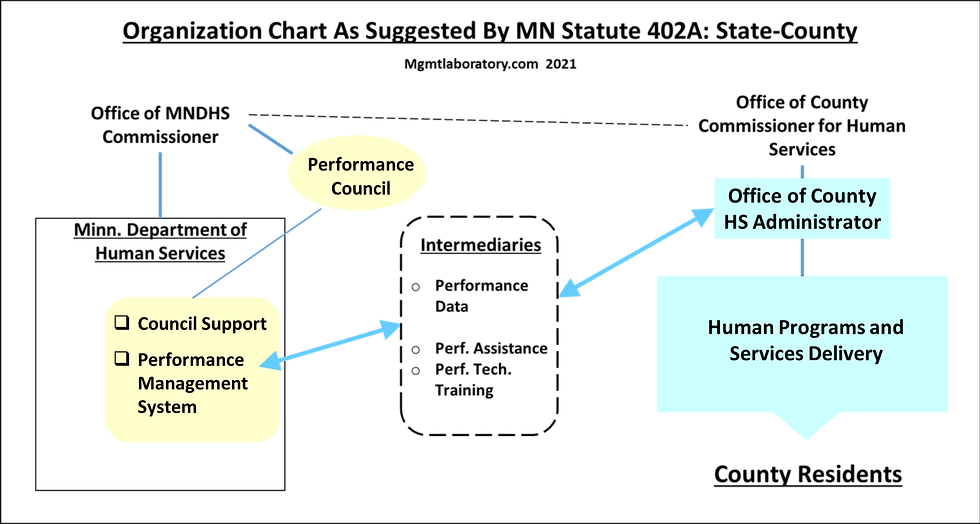Analysis of Statutes Governing Service Delivery Performance. Part 3
- Staff
- Jul 27
- 7 min read
This article is the third in a series that explores legislative analyses of laws related to human services delivery performance for state residents. The previous articles (1) and (2) detailed the legislative history from its inception. The operational steps outlined in the statutes were identified or inferred using management principles (3)(5)(7)(8). This analysis will proceed by creating idealized maps of the implementation processes for the duties of the Human Services Performance Council, tasks 1 to 10 (4). The series of articles summarizes the research, interviews, and observations from the meetings conducted by the Minnesota Department of Human Services Performance Council.

The Department of Health and Human Services in Minnesota seeks and secures funding, channels these resources through legislative processes to develop social service programs, and oversees their delivery to state residents.
Administrators of counties and agencies consider a range of factors—cultural, demographic, economic, ethical, legal, political, and technological influences—to achieve their objectives. The ultimate goal is to ensure that those in need are adequately served and that the quality of services provided meets high standards.
The human services budget dictates the extent of service coverage, while quality standards are set through laws passed in the legislative process. An effective administrator will strive to understand how these laws impact service delivery operations. The Human Services Performance Council was one of the five key elements of Minnesota’s State-County Results, Accountability, and Service Delivery Reform Act, enacted on May 14, 2009 (4). An amendment to Chapter 402A required the Commissioner to convene the Council to provide advice on the implementation and operation of the Performance Management System for human services. Established in January 2014, this group was responsible for creating performance measures and thresholds for the delivery of essential human services.

Role of the Performance Council:
The Performance Council completes the administrative process for overseeing the quality of human services provided. The Department of Human Services and the Performance Management System send transactional data regarding the services accessed by county residents. Key information about outcomes is then forwarded to the Performance Council. Advisories, feedback, poor performances, and suggested action plans are communicated to the Commissioner of the State's human services department.

Chapter 402A of the Minnesota Statutes outlines 10 statutory responsibilities of the Council. The main goal is to inform the Commissioner about the effectiveness of human services delivery, as executed by the Human Services Department, counties, and service delivery authorities.

Performance Management System-Level 2.
The human services performance management system uses the State's resources to develop and maintain performance measurements and support the operations of the performance council. The processes involved include the following:
Operational planning management principles involve adjusting the previous year's action plans to align with the measured variance between actual outcomes and the goals and objectives of the Management System.
Action plans involve elements concerning the ongoing enhancement of performance measurement and the creation of new metrics.
The implementation of action plans includes the deployment of new or improved measures and training of relevant State and county personnel.
The outcomes of human services delivery, assessed through these measures, are tracked and evaluated.
Performance exceptions identified in the previous step are addressed with new action plans.
The performance council concurs and sends the recommendation to the Commissioner.

Council Duty #5 and #6. Inadequate Improvement Plan Implementation and Resolution of Remedial Appeals.
In the fifth subprocess of the human services performance management system, performance exceptions occur when standards are not met or when there is insufficient remediation of an error correction or improvement plan:
Data and information are analyzed to define and confirm the performance measurement exception leading to the Commissioner's denial.
The County discovered unexpected operational factors that impacted its delivery processes and submitted an appeal, citing this extenuating circumstance.
The appeal was reviewed by the Performance Council, which recommended denial of the Commissioner's appeal.
The County develops an improvement plan or revises an existing plan.
The County implemented its PIP, but the results fell short of expectations, as noted by the Performance Council, and were considered inadequate.
The Performance Council recommends, and the Commissioner rules on a higher-level remedy.

Council Duty #7. Recommendations on Development and Update of Performance Measures.
The Performance Management System includes performance measure development or improvement in its operational plan.
Design a new or improved performance measure. Develop the latest or improved measure.
Test and train staff of MNDHS, counties, and SDAs on new or improved measures.
Deploy newly developed measures. Monitor the effectiveness of current measures and analyze exceptions.
Recommend new measure development or improvement of existing measures.

Council Duty #8. Recommendations on Removal of Rules and Statute Barriers.
Determine external operational factors that negatively impact the quality or performance of human services delivery. These factors are prioritized, and the most significant barrier is selected for analysis.
Identify the barrier and gather data for analysis to assess how significantly this factor impacts performance measures.
Perform a cost-benefit analysis to evaluate the elimination or reduction of the negative impacts of the barrier on the performance management system.
Recommend legislative or administrative actions to the Commissioner.

Council Duty #9. Collect Voice-of-Customer and Voice-of-Process for Improvement of Performance Management System.
Plan periodic Voice of Stakeholder and Voice of Process surveys.
Design the survey questionnaires and survey process.
Deploy the survey, collect responses, and tabulate the data.
Analyze data to understand performance improvements expressed by the Voice of the Stakeholder and the Voice of the Process.
Recommend to the Commissioner any Performance Management System improvement plan.
Council Duty #10. Submit Annual Report to Legislators and Commission
Publish an Annual Report for Minnesota Residents on the Performance of their Human Services Delivery System.
The Commissioner’s page.
Human services delivery and performance summary page: (a) results of the year’s delivery operations, (b) changes to the 5-year trend by current year service delivery performance. Short discussion of operational and external factors that caused the changes in delivery performance.
A brief discussion, in a page or two, should outline any changes in the strategic and operational plan to mitigate the effects of adverse factors and barriers.
In a separately bound supplement, discuss in detail the results of the operation of the Human Services Performance Management System as summarized in the separately bound annual report.
Observations From Analysis
The statutes concerning the supervisory responsibilities of Minnesota's Human Services Performance Council were process-mapped using the "process door (9)." Management principles were applied to deduce processes as outlined by the statutes. This analysis resulted in the following observations:
The statutes indicated a certain level of ambiguity in a human services performance management system, which we demonstrated as follows. The scope of the system falls under the supervision of the Human Services Performance Council;

Concepts like a "balanced set of program measures" appear unrelated to performance measures or significant for delivery performance evaluation. While a balanced set might be essential for performance measurement, there's no explanation of its critical role in the human services performance management system.
“Measure” is defined as a quantitative indicator of a performance outcome. We view measurement as an indicator of service delivery performance, expected to bring about the desired recipient outcome. Statutes should provide for the development, training, effectiveness monitoring, and revision.
A "Performance improvement plan" is considered a set of steps intended to enhance performance on one or more specific measures. We believe this is a sequence of steps that will be taken to improve service delivery results, enabling the County or service delivery authority to achieve a specific performance measure.
The “human services performance management system” is described as a performance data collection process that is part of the Department of Human Services. Data collection and processing are only a part of a whole with a definite boundary, containing the human services department, the Commissioner, counties, service delivery authorities, and service recipients. A human services performance management system is illustrated above. The system encompasses service origination processes, service delivery processes, recipient management, funding flows, process design, training, transactions, and performance data.
Publish an annual summary human services management system report to the residents of the State, and a comprehensive report supplementary to the annual report. The annual report for state residents on the performance of their human services delivery system includes: the Commissioner's statement page; human services delivery performance summary on results of the year's delivery operations and changes to the 5-year trend by current year service delivery performance; short discussion of operational and external factors that caused the changes in delivery performance; and a short discussion on any changes on the department's strategic and operational plan to mitigate the effects of adverse factors and barriers. The supplementary report to the annual report of the annual human services measurement management report includes: a list of counties or service delivery authorities that have been required to create performance improvement plans and the areas identified for improvement in the remedies process; a summary of performance improvement training and technical assistance activities offered to county personnel by the department; recommendations on administrative rules or state statutes that could be repealed to improve service delivery; recommendation for system improvements, including updates to system performance measures and standards.
An article will follow these analytical series, showing how the statutes may be revised to improve consistency of terms and how these statutes are implemented.
By the Staff, www.mgmtlaboratory.com 2025.
References:
Analysis of Statutes Governing Service Delivery Performance. Part II. www.mgmtlaboratory.com. Jan, 2025.
Analysis of Statutes Governing Service Delivery Performance. Part I. www.mgmtlaboratory.com. Dec, 2024.
Performance Management and Organizational Structure. www.mgmtlaboratory.com. Aug, 2021
Essential Human Services; County Delivery; State-County Results, Accountability and Service Delivery. Chapters 402A.01 to 402A.50. www.revisor.mn.gov/statutes/2021. Nov 2021.
Minnesota Department of Human Services: A Case Study in Management Control Systems. www.mgmtlaboratory.com. Nov, 2019.
Process Mapping in Continuous Improvement of Public Service. www.mgmtlaboratory.com. Jun, 2019.
Where has MIS Gone? www.mgmtlaboratory.com. Feb, 2018.
Program Completion and Management Action Delay. www.mgmtlaboratory.com. Nov 2017.
Within Six Sigma continuous improvement projects, analytical tools are categorized into those in the "Data Door" and those in the “Process Door.” Process mapping is an analytical tool in the process door.
Mgmtlaboratory.com staff and affiliated management consultants are experienced in managing private and public organizations, utilizing management tools. Non-profit entities and governments may inquire at contact@mgmtlaboratory.com about its free online consulting service on continuous improvement and other service administration tools. tools.







Commentaires